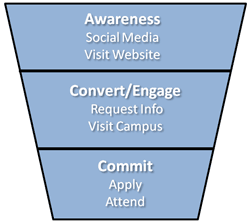The other week a report from the University of Massachusetts Dartmouth on “Social Media ROI” started a wave of discussions and follow-up posts. One of these follow-up posts written by Michael Stoner does a great job of getting into the problems of the report and the selective nature of the findings. One of his final points really stood out to me, and I want to share it with you here.
Measuring ROI is complicated, especially in higher ed. If we know anything about measurement in higher ed, it’s complicated and undisciplined.
Michael is mostly right here. For me measuring ROI comes back to the bottom line and how you attribute social media to revenue. It’s not that measuring ROI is complicated or hard but more on the second point that institutions simply aren’t disciplined enough to do it. I’ll go so far as to say higher ed is lazy for not doing a better job of measuring ROI. After I left my job at a college I spent three years working in the private sector at HubSpot and I can tell you that back in 2009 we were able to measure the number of customers that came through Twitter and the revenue associated with those customers. I’ve gotten flack from this audience in the past talking about how schools need to be run more like businesses and this measuring of ROI is another classic example of how undisciplined schools are.
The truth is if a marketing individual at a private business spent as much money as some admission or marketing departments in higher education do and could not tie that back to a tangible, financial benefit then they would be fired. There is a ton of wasteful, irresponsible spending in higher education. I’m going to get off this soap box here though and let’s talk about measuring ROI.
Measuring ROI
Before we talk about how to attribute ROI to social media we need to understand how to measure ROI in a more general sense. 50-75% of every institution’s annual revenue comes from enrollment. Private institutions are on the higher end of this compared to public institutions. So basically, if we aren’t bringing new paying students in and retaining them then the school will cease to exist. Enrollment is the single most important activity a school can do from a financial standpoint. Enrollment is the main goal and should be your top priority. Everything else is a secondary goal… PERIOD. It is impossible to measure ROI unless you know what the value of a student is to your institution. Once you know the value of a student then you can start attributing specific activities and conversions on your website to impact this outcome, including social media. I’ve written on these two subjects before so I’ll just link to the first two steps here.
- Understand the value of a student to your institution
- Figure out your marketing funnels and conversion activities
So How Do I Specifically Measure Social Media?
The truth is with a little web data and understanding the financial value of a student you can tie a dollar value to every conversion on your website. For social media specifically you need to take it a step further and establish how your engagement on those channels leads to these website conversions and ultimately a prospective student applying in this example.
The problem is most schools’ marketing funnels and conversion processes are quite lacking. Students do not apply to your school through your Facebook page, do they? If you aren’t sharing and offering content that drives them back to your website where they can convert on things that bring them closer to applying then of course you can’t measure the ROI.
How Does Web Analytics Tie Into This?
The great thing about the web is that you can measure everything. I know from the 2012 State of Social Media and Web Analytics report that 97% of schools are tracking web traffic data. Despite this high adoption only 18% track online donations, only 31% track online applications, and only 35% track online inquiries to admissions. What is the point of web analytics if you aren’t going to go all the way? These schools all have broken metrics in the middle of their funnel so there is no way that they can measure the ROI of social media.
I’ve said it before and I’ll say it again… Who cares about how much traffic you get to your website if you aren’t tracking conversions? You could, through social media and SEO efforts, theoretically double web traffic to your website, and if you aren’t doubling the number of inquires, applicants, and other conversion activities then who cares about all the extra traffic? You are wasting your time and the college’s money on activities that aren’t impacting the bottom line!
The Big Takeaway
Ask yourself how you justify which web projects your school takes on. You should be making these decisions and justifying your selection by how it can impact the bottom line. If you do not have this measurement system in place then honestly you should stop everything else that you are doing and put it in place. Otherwise you are probably about to start another project that is a waste of money and time. Start with the value of a student, map out your critical conversions and how you will increase them, and think through how all your web activities tie into these metrics.
Also I will tell you from experience when you can propose a project in such a way where you can explain how it is financially beneficial to your institution you will build a ton of credibility, you are more likely to get the project approved, and you will set a standard of accountability that is severely lacking in higher education.
So that is my hard knocks lesson on social media ROI. Let the comments of how I have no idea how higher education works begin.
Link

